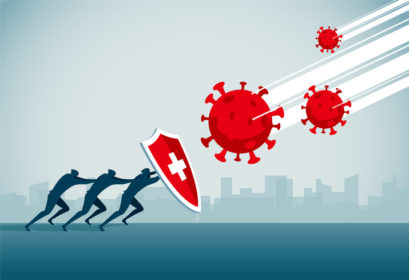Normalcy Delayed: Spike in COVID-19 Cases Brings New Lockdowns

November 25, 2020 – They have spent millions redesigning offices to reduce COVID-19 risk. Special protocols were set by overworked human resources departments. Now, just as staffers were returning and resuming a semblance of normal operations, the world has shifted for corporations once more, according to a new report by Korn Ferry.
The shift, of course, is the dramatic and tragic rise in COVID-19 cases—now totaling a million a week in the U.S.—that has forced cities and towns to resume full or partial lockdowns or discussions about implementing them. “And while companies are more accustomed to the drill that they experienced last spring, this comes just as corporate leaders were inching toward more normal business operations,” the Korn Ferry report said. At last count, nearly two-thirds of workers in the U.S. had returned to the office at least some of the time, an increase from just one-third last April, according to one poll.
Nathan Blain, Korn Ferry’s global solutions leader for organizational strategy, said that the promise of a vaccine in coming months is a “light at the end of the tunnel that softens the blow. But for now, leaders face the difficulty of trying to guess which governments are or may be shutting things down—an inconsistency that leaves the C-suite and employees alike in limbo,” he said. “One state may not have any new restrictions, while a neighboring state may have closed many indoor businesses. This is incredibly frustrating for leaders. It is a step backward for all of us.”
Just a month ago, and through most of the fall, many companies were optimistically aiming for a return to normalcy, or as close to normal as they could while adhering to social distancing guidelines. Much of that will be on hold again. “The story of the next few weeks will be a gradual and uneven—but unambiguous—tightening of anti-COVID-19 restrictions across the country,” Ian Shepherdson, chief economist for Pantheon Macroeconomics, recently said. “The rapid rate of growth of cases and infections threatens to overwhelm the hospital system by the end of the year.”
“The next wave of lockdowns represents a serious challenge for leaders dealing with already burned-out employees,” said Melissa Swift, global solutions leader for Korn Ferry’s digital transformation advisory. She called the timing doubly unfortunate, “because even in a normal year, November/December is a time that employees grapple with burnout.”
Related: COVID-19 and Middle-Market Companies: Key Insights for Recovery
“Companies that rely on face-to-face interaction for sales could once again struggle,” said Mr. Blain. “It’s particularly difficult for travel and hospitality firms, whose revenue streams are dependent on customers showing up at a certain venue. And then there are the workers themselves.”
 Virtual Encounters of the Best Kind
Virtual Encounters of the Best Kind
As remote work becomes more prominent in everyone’s life, it is vital that executives pay extra attention to their virtual business interactions. Without personal contact, culture becomes harder to convey. Technical difficulties become obstacles to communication. And personal chemistry is more challenging to establish. These days, it seems more critical than ever that encounters are well planned, well-managed and efficient.
In a recent report, Edouard Thoumyre, CEO of ACCUR Recruiting Services, offered a number of tips for conducting better online meetings and interviews. Here, he focuses on paying attention to technical fixes such as sound, lighting, background, and optimizing settings, as well as building better meetings and better online interviews.
To be sure, many companies will be able to rely on past lockdowns to help navigate any current ones. “They have learned how to distribute masks to employees, encourage social distancing and install plexiglass shields,” said Craig Rowley, a Korn Ferry senior client partner who specializes in retail. “Some essential retailers might have gotten a little lax in mask enforcement but will become more vigilant again as the virus surges everywhere. As for businesses that went fully remote, everyone has confidence that if you had to send everyone home, you can get it done in 24 hours now,” he said.
Employee Burnout
Leaders also have a lot more knowledge about their employees than they did last time. Many know that many workers are at their wit’s end. According to one recent survey, nearly six in 10 employees reported feeling burned out now, compared to 45 percent in April. Moreover, as it becomes clear that the pandemic isn’t going away anytime soon, Korn Ferry said more employees are blaming the virus for their burnout, citing it as responsible for increased workloads, lack of support and unclear performance expectations.
Experts say the increase in instances of burnout is troubling given that employees have had some time to adjust to the “new normal” of remote working and fear of layoffs. What’s more, organizations have ramped up wellness efforts over the last four months. Now, however, the concern for organizations is employees sliding from burnout into anxiety, depression or worse. “Organizations are looking hard at the impact that diminished informal interaction and personal support is having on employees,” said Mark Royal, a Korn Ferry senior director focused on employee engagement. “Leaders are now hopefully communicating and checking in on employees and listening to and addressing their concerns.”
Although they can’t control any new lockdowns, leaders can begin to envision what the workplace will be like when the pandemic finally ends, experts say. By all accounts, effective vaccines could be widely distributed, at least in the U.S., sometime in the spring.
Because of that, Korn Ferry said, “companies can get serious about deciding which changes implemented during the pandemic should become permanent. Leaders can also start determining how much office real estate they really need and what type of policies they want to have for remote work.” Before the news about the vaccines, all those discussions were just academic. “This can be a huge time for decision-making,” Mr. Blain said:
Related: As COVID-19 Lockdowns Mount, More Americans Expected to File for Unemployment
Contributed by Scott A. Scanlon, Editor-in-Chief; Dale M. Zupsansky, Managing Editor; and Stephen Sawicki, Managing Editor – Hunt Scanlon Media














